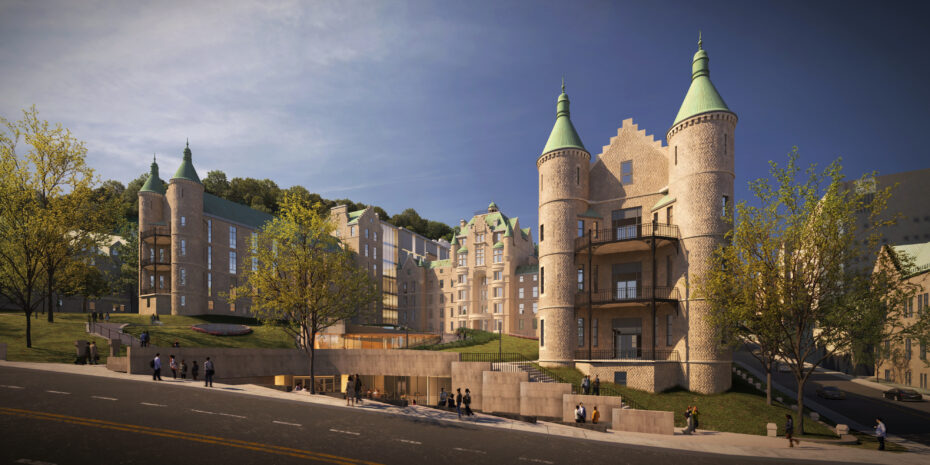
McGill has developed a plan to turn a portion of the site of the old Royal Victoria Hospital into a state-of-the-art learning and research complex. In keeping with the University’s commitment to reconciliation, planning the New Vic includes ongoing efforts to engage Indigenous peoples in conversations about incorporating Indigenous physical representation in the design of this ambitious project.
McGill’s downtown campus, and the adjacent former site of the Royal Victoria Hospital, sit on the traditional site of meeting and exchange among Indigenous peoples, including the Haudenosaunee and Anishinaabe nations. The Quebec government is responsible for the requalification and management of the former hospital site.
In 2017, McGill Provost Christopher Manfredi led a Task Force on Indigenous Studies and Indigenous Education, which had a mandate to “identify, explore and advance ideas, initiatives and plans that will embed Indigeneity in the life and activities of the University while seeking to enhance the presence and success of Indigenous students, faculty and staff.” The Task Force’s 52 calls to action include making Indigeneity part of our campuses’ physical spaces.
“Since the early days of the New Vic Project, the voices and experiences of Indigenous people have been considered an integral part of the design process,” says Provost Manfredi.
Indigenous community engagement has allowed McGill to strengthen its connection with local Indigenous Elders. These relationships have become all the more important as the University seeks to better understand how the communities wish to move forward in light of recent allegations about possible unmarked graves near the Allan Memorial Institute. Citing the Final Report of the federal Truth and Reconciliation Commission, which states that “reconciliation is not possible without knowing the truth,” Provost Manfredi says the University is committed to supporting the Société québécoise des infrastructures and the ministère de la Santé et des Services sociaux in further investigating these allegations.
Over the past two years, more than 50 Indigenous community members have already been involved in dozens of meetings and workshops about the New Vic Project. The Provost says those critical conversations will continue.
“We are learning together as we navigate this important, unprecedented and transformative journey for the University,” he says.
A place of healing
For more than a century, the Royal Victoria Hospital has played a central role in the circle of life for thousands upon thousands of Montrealers and Quebecers — yet, since time immemorial, the site has also been an important place of meeting and exchange between Indigenous peoples. In 2005, the Government of Quebec designated Mount Royal and its surroundings as a Historic and Natural District, in recognition of its natural environment as well as longstanding significance for Indigenous people.
The idea behind the New Vic Project is to transform the main Royal Victoria heritage buildings, combined with new construction, into a mixed-used complex of multidisciplinary education and research that will be anchored by Sustainability Systems (which brings together Molecular–Materials Systems, Earth Systems, and Urban systems) and the Max Bell School of Public Policy. When completed, the New Vic will bring together approximately 150 professors and their associated research groups (representing some 850 grad students and postdoctoral fellows) from 20-something departments across the University. Add in undergraduates attending lectures or studying on site, and support staff, and the New Vic will welcome somewhere in the order of 3,000 people per day.
“Healing is at the heart of the New Vic Project,” says Provost Manfredi. “For a century, the Royal Victoria Hospital healed the sick. We now have an opportunity to transform the site into an interdisciplinary, sustainability-focused teaching, learning, and research hub with a critical new mission: to help heal the planet.
“But for the New Vic to truly realize its full potential, it must be guided meaningfully by the University’s commitment to reconciliation. The New Vic’s efforts to address global challenges will benefit from Indigenous peoples’ traditional knowledge of sustainability (e.g., Seventh Generation Principle), while reconciliation is key to social sustainability in Canada.”
Read more about the New Vic project.
